06 - The Journey from Ibersheim to America
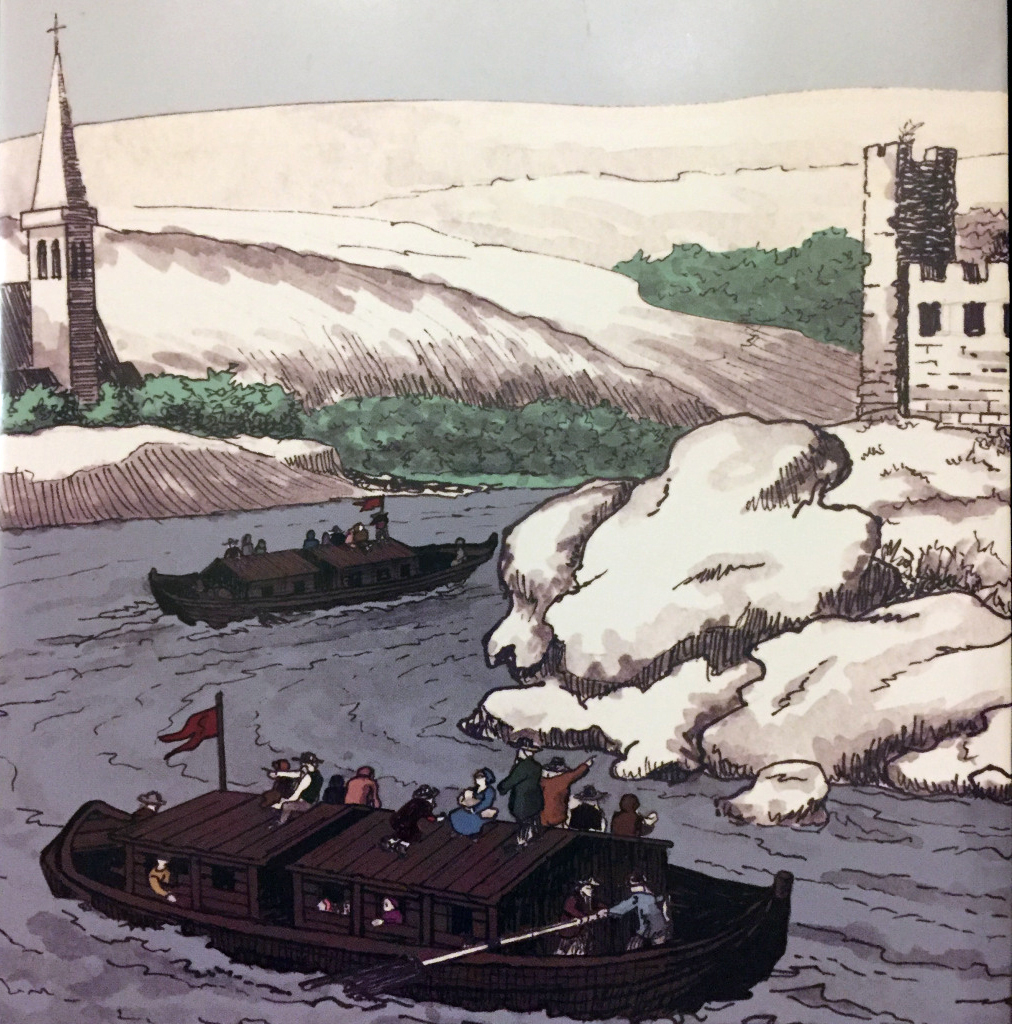
In early 1727, Henrich Hiestand probably boarded a barge in Worms, much like the one above, saying a “forever” goodbye to his Ibersheim family.
Of the Mennonites who emigrated from the Rhine lands, “only a small proportion—roughly 10 percent—journeyed overseas. The vast majority relocated in eastern Europe.”[i] Think about that—if Henrich Hiestand had gone east, instead of west to America, our Hiestand/Haston family might have been Prussians, Hungarians, Polish, or Russians! But, fortunately for us, the lure of America drew him to Pennsylvania.
[i] Marianne S. Wokeck, Trade in Strangers: The Beginnings of Mass Migration to North America. (Philadelphia: The Pennsylvania State University, 1999), 8.
Henrich Hiestand was one of those immigrants from the Rhineland who disembarked in Philadelphia. But we do not know what ship he traveled on or exactly when it arrived in the colony of Pennsylvania. Nor do we know any other details regarding his journey to America, other than he left Europe, he survived the Atlantic passage, and he made it to America. And here we are!
Reasons for Emigration
There were several compelling reasons why a person, especially a Mennonite, living in the Palatinate in the late 1600s to the mid-1700s would choose America over his or her relatively-recent German homeland. Most Palatine emigrants were probably motivated by some combination of the following reasons.
Political Peace and Stability
It is little wonder that some historians have referred to the Palatinate of the 18th century as “the Land of Wars.”[i] Why did Rhinelanders flee the Palatinate during these years? Perhaps a better question is why would any of them remain there, if given an opportunity to leave?
[i] Charles R. Haller, Across the Atlantic and Beyond: The Migration of German and Swiss Immigrants to America. (Westminster, MD: Heritage Books, 2008), 219.
Economic Prosperity
If political instability and war were the “push” behind the waves of Mennonite emigration from Europe, the “pull” was the promise, or at least hope, of economic prosperity. Many of the industrious, but often impoverished, Mennonites were lured away to America in search of land, freedom from severe taxes, and an overall hope of living a financially secure life.
And available land for Mennonites in the Palatinate was becoming more and more scarce. By the time our Henrich Hiestand became an adult, his only hope for sufficient land to support a family was to move far away. The tenant land his grandfather inherited had already been subdivided several times to provide farmland for his father, uncles, and perhaps older brothers.
Religious Freedom
Many Mennonites left Europe for America, at least partially, because of religious persecution. Even though the types and degrees of persecution they experienced in the Palatinate were light compared to what they had endured in Switzerland, the religious toleration for Mennonites of the Palatinate was always limited. They were forced to pay “protection fees” and lived under constraints not applied to Catholics, Calvinists, or members of the Reformed Church. And the rules and limits of toleration changed, often for worse, with the empowerment of new rulers.
William Penn had personally visited the Palatinate, probably even to the village of Ibersheim, with promises of true religious freedom in Penns Woods (Pennsylvania), the American colony his father had received as a grant from King Charles II of England.
The Emigration Route to America
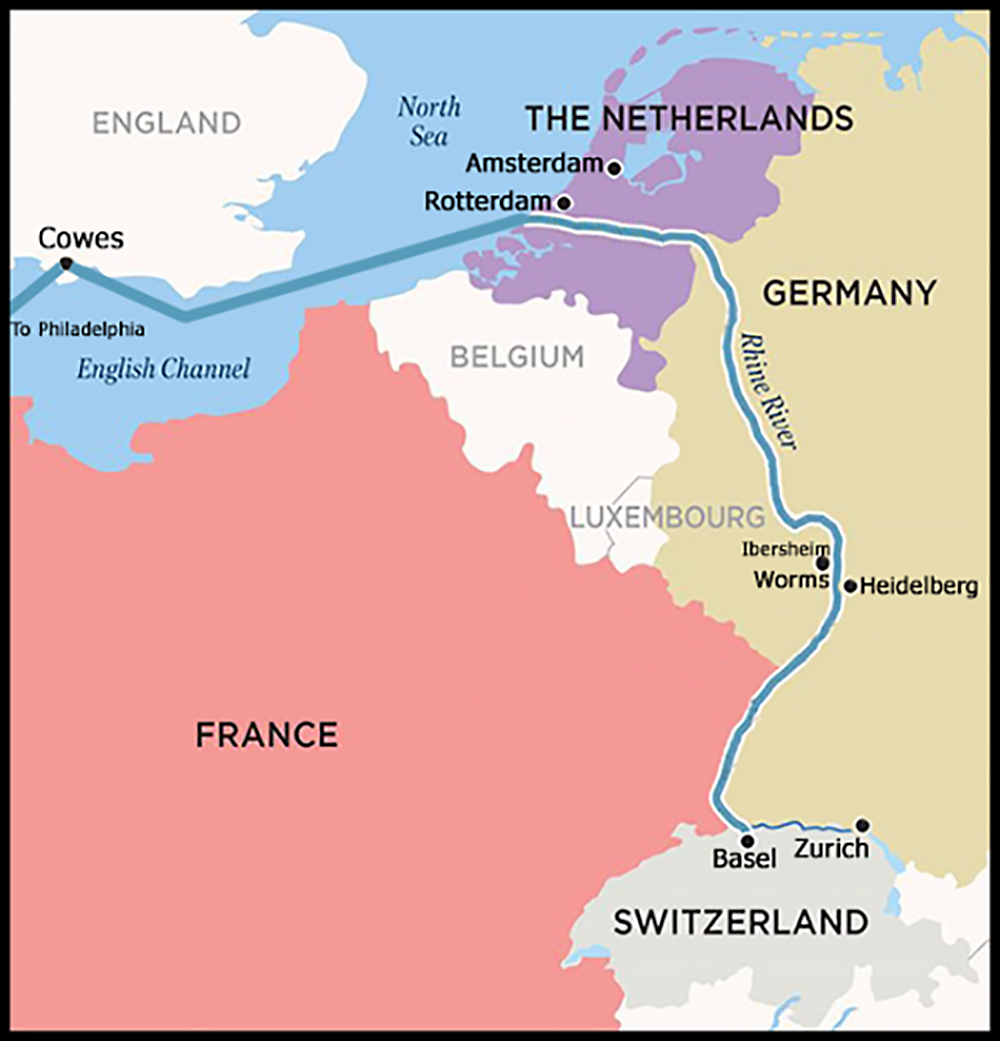
For the Rhinelanders headed to America, including our Henrich Hiestand, the journey from Ibersheim and other villages of the Palatinate was comprised of three phases.
Phase 1: Down the Rhine River to Rotterdam in Holland
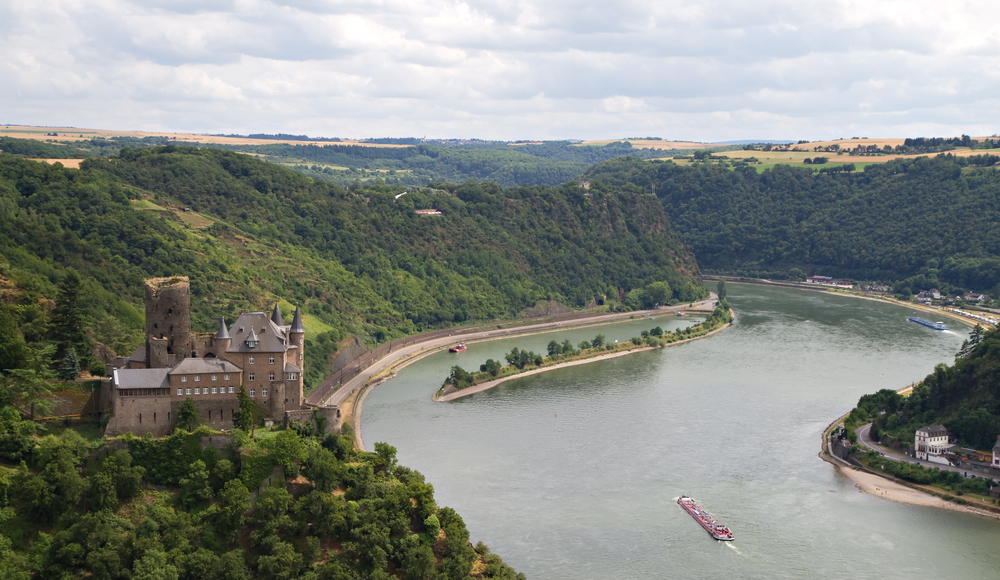
The Rhine River has been called the “River of Destiny.”[i] Hundreds of thousands of Swiss and Germans sought their destinies by floating down the Rhine on barges, from the mid-17th century until the mid-19th century.
[i] Charles R. Haller, Across the Atlantic and Beyond: The Migration of German and Swiss Immigrants to America, 239.
Under good river conditions, the trip down the Rhine from Ibersheim to Rotterdam (approximately 375 miles or 600 km) could have taken only six or seven days of actual floating time, at about 2 ½ miles per hour. But there were many toll stations (associated with toll castles) along the way. Maybe as many two dozen or more toll stations were active in the early 1700s, from Worms to Rotterdam. [i] The toll castles belonged to territorial lords or to their authorized vassals.
[i] Charles R. Haller, Across the Atlantic and Beyond: The Migration of German and Swiss Immigrants to America, 242-245.Ibersheim
In addition to collecting tolls and searching the barges, the stops also delayed boats long enough to encourage (or coerce) passengers to spend money with the merchants of the castle. Consequently, toll station stops probably extended the river trip from Worms to Rotterdam from taking a few days to taking a few weeks, perhaps a month or so.[i]
[i] Ralph Beaver Strassburger, Pennsylvania German Pioneers, xxxiii.
Phase 2: Across the North Sea and English Channel to an English Port
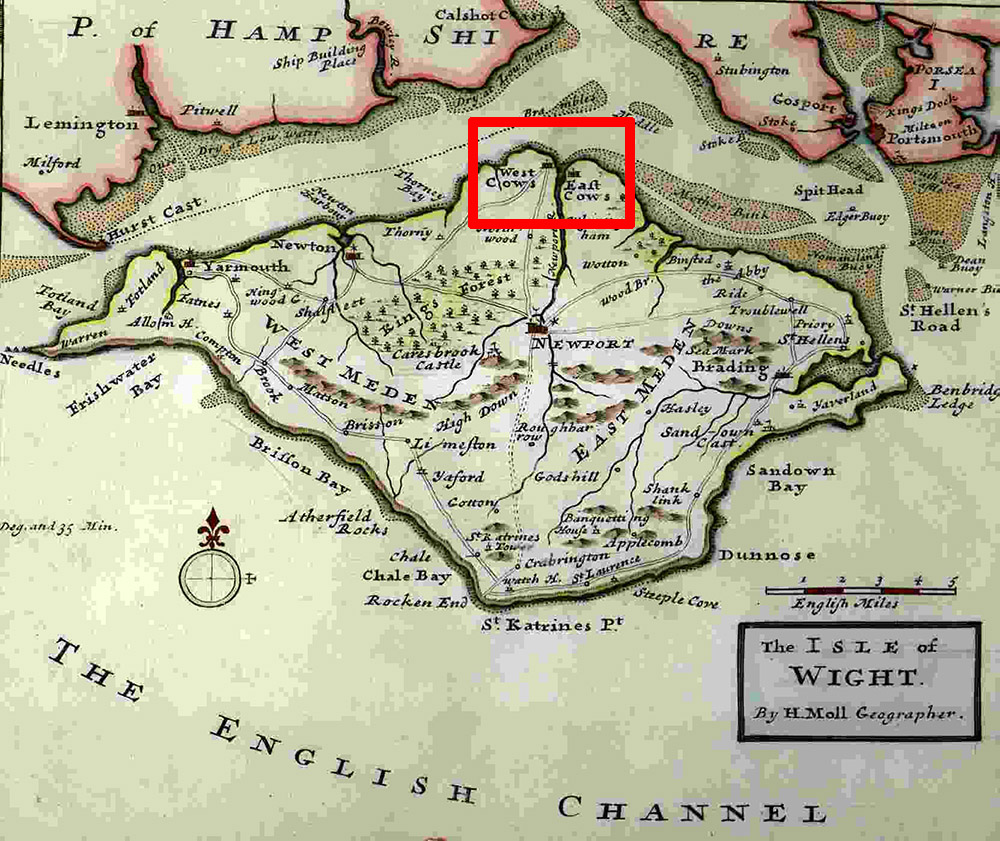
Prior to 1783, ships sailing through the English Channel were required by British navigation laws to stop in one of several English ports. Only British-owned and operated ships were allowed to engage in business with the British colonies.[i] There were multiple English ports, including London, from which European ships set sail.
But, after the earlier phases of emigration, the most popular port for these journeys was the port of Cowes on the northern coast of the Isle of Wight. One hundred and forty-two ships are recorded as having sailed from Rotterdam to Cowes.[ii]
[i] Charles R. Haller, Across the Atlantic and Beyond: The Migration of German and Swiss Immigrants to America, 239.
[ii] Ralph Beaver Strassburger and William John Hinke, Pennsylvania German Pioneers, Volume I, 1727-1775, (1934 reprint; Baltimore: Genealogical Publishing Company, 1966), xxxiv.
Phase 3: The Trans-Atlantic Journey

Most passenger ships sailed across the Atlantic in the mid-year season of late spring through early autumn, May through October. If the weather and wind conditions were favorable, the journey could have taken as few as seven weeks, but eight to twelve weeks were more common. Occasionally, extreme weather would blow a ship off course and the trip would be even longer.
Much has been written about the conditions that existed on these ships. In some cases, the journey was relatively easy when weather was favorable and the ship’s captain and crew were decent people. But many of these voyages were nightmarish.
The Atlantic nightmares began when greedy ship captains overloaded their ships, packing passengers in sleeping quarters so tightly that they were barely able to move. Often there was no room left for personal belongings and passengers were forced to leave their trunks of family heirlooms behind.
Living conditions on many of the ships were deplorable:
- Passenger ships were packed well beyond comfortable space. Bunk space was commonly limited to six feet long and one one-half feet wide with very limited vertical space.
- Food quantities were limited and when the journey took longer than expected, the amount of food was rationed to such small amounts that passengers were constantly hungry and some of them starved to death.
- Food quality, which was never good from day one on the ships, only worsened throughout the voyage. For example, biscuits became dirty, hard and crusty, and infested with worms. Meat, even though heavily salted, spoiled. In some cases, passengers were forced to resort to eating mice and rats.
- Drinking water was limited, sometimes becoming dark and thick and full of worms. Often passengers died of typhoid fever from drinking the water.
- Lice infestations abounded, to the point that lice were sometimes so thick on the bodies of people that they were scraped off in swarms.
- Extreme temperatures, both heat and cold, took the lives of many passengers.
- There were no provisions for sanitation, so filth and stench from vomiting, sweat, urine and feces was unimaginable.
- Sometimes gales lasted for two or three days and nights and passengers tumbled over each other, both the sick and the well.
- Impatience mounted and passengers cursed and fought each other, even their own loved ones.
- Cheating and theft were commonplace.
- Children and the elderly were often the first to die. Many parents watched their children die and their bodies cast into the ocean.
- Overall, the mortality rates on some of these ships were incredible.
There is no known record of which ship carried Henrich Hiestand to America or any extant reports of his experiences en route to Pennsylvania. Whether he was one of the more fortunate travelers or one of the miserable survivors of a horrendous trip, we do not know. IF he made it to America in 1727, prior to September 14, 1727 (when ships’ passenger lists were kept), then his early arrival in the shipping season would seem to indicate that the conditions of his journey might have been more favorable than most unless he traveled in the first few months of the year. Fortunately for Henrich Hiestand and those of us who have descended from him, he did survive the trans-Atlantic passage.
Arrival in Philadelphia
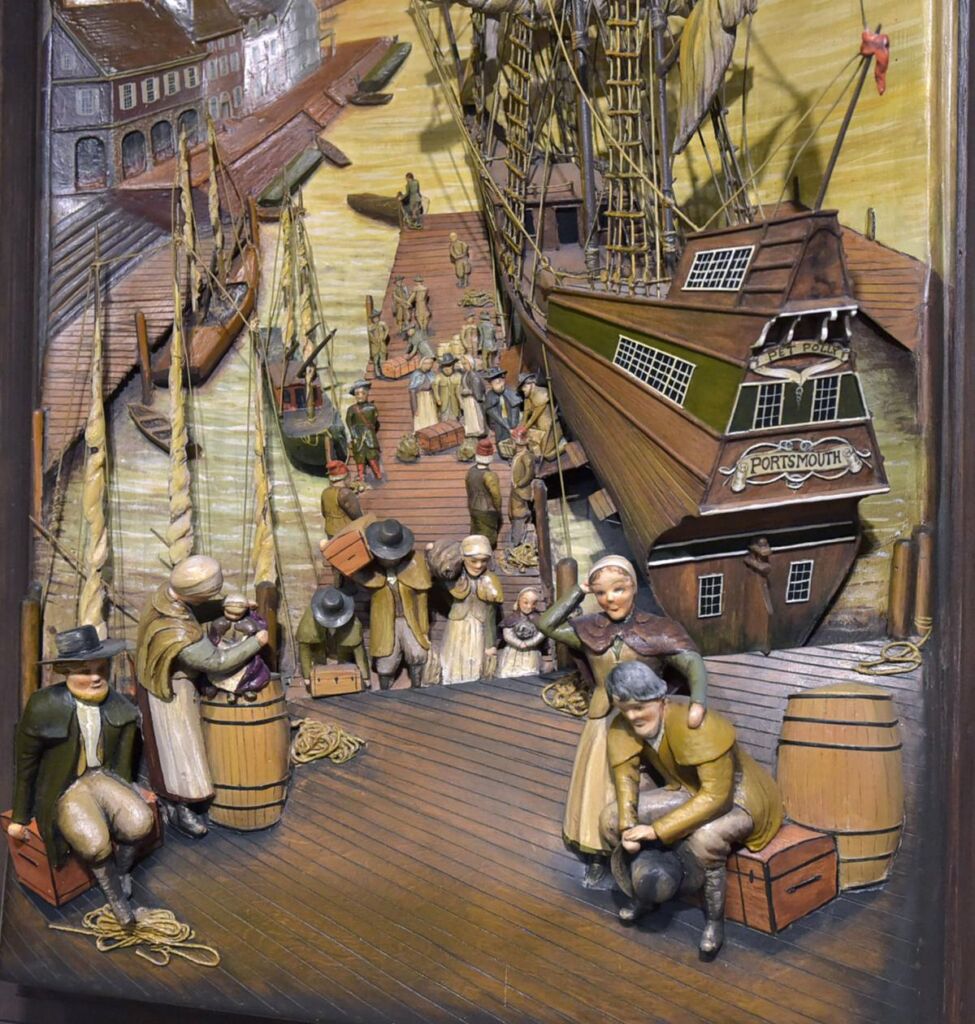
It was an exciting and joyous time, when a ship with German immigrants entered the Philadelphia harbor, but their drama was not over. The authority for de-boarding was vested in Philadelphia health officials, as well as the captain of the ship.
Passengers had to settle their debts with the ship’s captain. If they could afford to pay, they were allowed to leave the ship as soon as their financial obligations were settled with the captain. But many of them were unable to make the necessary payment. Even if they did leave their homes with money, often their funds were depleted by the time they paid all of the customs fees and other expenses associated with the various required landings and delays from home to the Atlantic.
Once researcher estimates that about half of the German-speaking immigrants were compelled to sell their services for several years as servants to wealthy masters in order to be released (into the custody of the master) from their ships.[i] These indentured servants became known as “redemptioners” because they had to work to redeem their freedom.
[i] Aaron Spencer Fogleman, Hopeful Journeys. (Philadelphia: University of Pennsylvania, Press, 1996), 73.
In the next article, you will learn about our Henrich Hiestand’s early years in America.
Mennonites Come to America
Old (1979) Video
If you enjoyed this article, please share it with others who might be interested.

